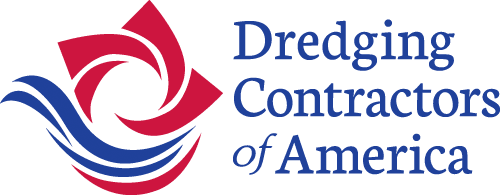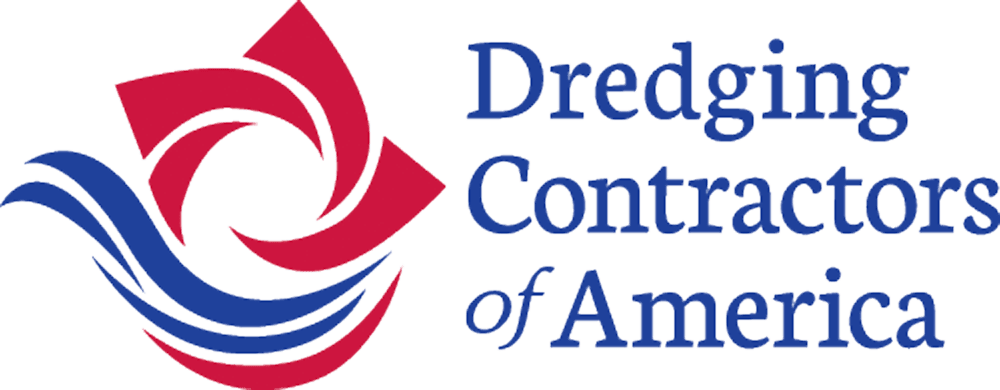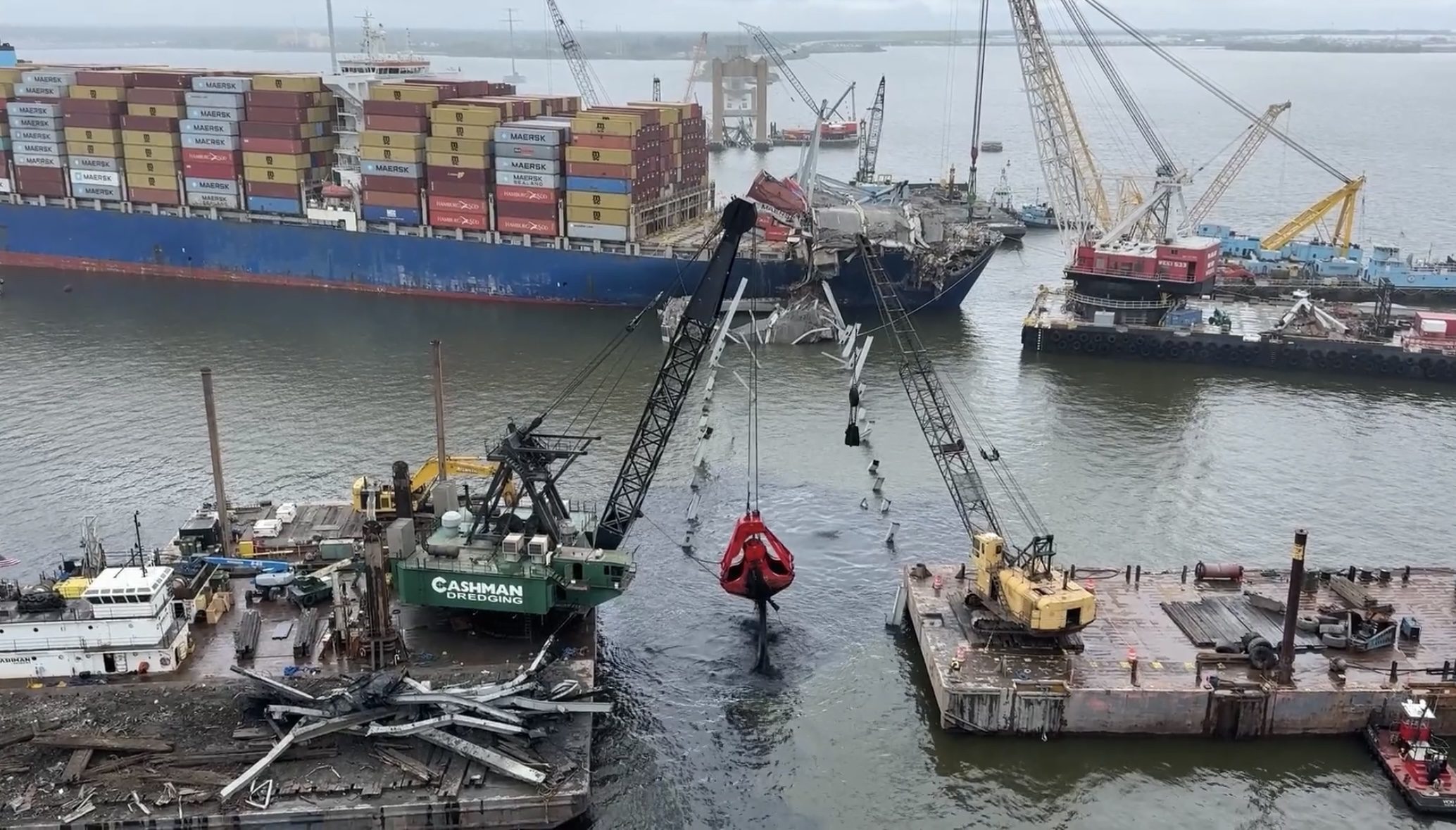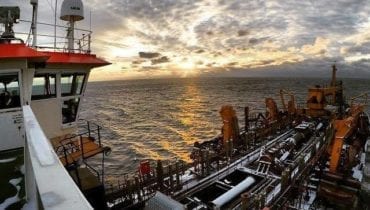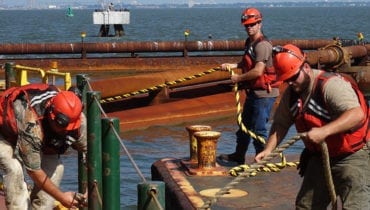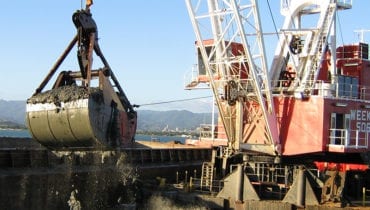By: William P. Doyle
Date: March 26, 2025
We are at the one-year since the Francis Scott Key (FSK) Bridge collapsed over the Patapsco River’s Fort McHenry Channel in Baltimore, Maryland. Nearly 100 percent of the cleanup; all of the wreckage and debris removal operations were conducted by the Jones Act private sector U.S. maritime industry.
The FSK bridge collapsed at about 1:28 a.m. local time on March 26, 2024 after the container ship MV DALI lost power and collided with one of bridge’s support piers. Six construction workers died in the collapse, while two other workers survived the fall into the freezing water. Our thoughts and prayers remain with the families who lost their loved ones.
The dredging and marine construction industry was heavily involved the cleanup and the expeditious reopening of the Fort McHenry Channel. I was alerted that the FSK Bridge had collapsed at around 3:00 a.m. by landowners around the Port of Baltimore. I immediately began calling and contacting Dredging Contractors of America dredging and marine construction companies to get an accounting of where their vessels, barges and equipment were located. I knew this was going to be a massive U.S. maritime private sector operation and believed we would clear the channel and open the Port of Baltimore faster than anyone could imagine.
The search and rescue efforts began immediately after the bridge collapsed with first responders racing to the FSK bridge area to look for survivors. This included local and state police, fire and rescue and the U.S. Coast Guard. Within the next 36 hours, the search and rescue turned into recovery operations. This included the careful removal of debris and wreckage while divers searched the waterway for the victims.
In that first 24 hours, the federal government set up a Unified Command of agencies to coordinate the recovery, wreckage and debris removal. The Baltimore maritime community had become well versed in the Unified Command structure as the FSK command was nearly identical to the first Unified Command that was set up two years earlier after the grounding of the 12,500 TEU containership MV EVER FORWARD. The same private sector Jones Act maritime companies that refloated the MV EVER FORWARD, were also involved in the FSK cleanup.
The lead agency for the FSK Unified Command was the U.S. Coast Guard. The U.S. Coast Guard and the U.S. Army Corps of Engineers acted as the subject matter experts and served as command and control overseeing the private sector. Other agencies involved in the Unified Command included the U.S. Navy, Federal Bureau of Investigation, Maryland Governor, MD Departments of Transportation, Environment and State Police.
Within the Unified Command Structure, there were three main salvage companies operating for separate entities on a contract management basis. U.S. Jones Act dredging, marine construction and salvage company DonJon Marine acted as the salvage operator on contract with the federal government. The MV DALI’s contracted salvage operator was Resolve Marine. And, the state of Maryland enlisted Skanska USA Inc.
While some perceived experts surmised that the port would be shut down for at least one-year, those of us the U.S. maritime industry knew it would not be a crippling long term shut down. We knew the American maritime industry with its dedicated companies and patriotic merchant mariners would show up and turn to. Clearing the channel and reopening the Port of Baltimore was going to take weeks, not a year or even several months.
The U.S.-Flag marine construction, dredging and maritime industry responded immediately to the collapse. In fact, Cashman Dredging and Marine Contracting had recently completed maintenance dredging of the Baltimore Harbor approach channels. As a result, Cashman had its DALE PYATT clamshell dredge, barges and other equipment anchored and stacked in Baltimore’s Curtis Bay. The DALE PYATT is one of the largest clam shell dredges in North America.
“At Cashman, we’re always ready to support America’s waterways,” said Stephen Tobin, Chief Executive Officer of Cashman Dredging and Marine Contracting. “With a significant fleet already stationed in Baltimore, we were able to mobilize immediately to help with the efforts to clear wreckage and restore safe navigation as quickly as possible.”
In addition, Gahagan & Bryant Associates/S.T. Hudson Engineers (GBA/Hudson) based in Tampa, Florida sent three of its vessels into the wreckage site. “We mobilized our hydrographic survey vessel, the SEAFIX, and had her onsite by 10:00 a.m. scanning the Patapsco River’s seafloor,” said Grady Bryant, Chief Executive Officer, GBA/Hudson. The company then brought in the BELLA MARIE and RV COASTAL, both vessels equipped with high resolution geophysical and geotechnical surveying capabilities. These vessels were very important in locating buried pipelines, fiber optic and utility lines crossing under the Fort McHenry Channel.
Within three days, the media described the operation as an ‘armada’ of vessels heading to Baltimore. In fact, upon the arrival of Don Jon Marine’s CHESAPEAKE 1000 heavy lift sheerleg crane ship on March 29, 2024, NBC News correspondent Tom Costello reported on live television: “It’s the largest on the east coast, part of an armada of barges, salvage vessels and tug boats on the way.”
At the height of the clean-up operations the fleet of ships, or armada of assets, dispatched to Baltimore included over 100 vessels of various sizes and capabilities, including:
- 36 barges,
- 27 tugboats,
- 22 floating cranes,
- 10 excavators,
- Several dredges,
- 3 survey boats
- Skimmer,
- And a Coast Guard Cutter
There were some notable ships, specialized vessels and heavy equipment assets that were dispatched to Baltimore for the cleanup and salvage operations. For instance, DonJon Marine’s CHESAPEAKE 1000 was utilized. It is the largest crane ship on the east coast, capable of lifting up to 1,000 short tons. The CHESAPEAKE 1000 employed the “Hydraulic Grabber,” a 200-ton hydraulic claw grab that is ordinarily used for decommissioning giant offshore oil and gas rigs.
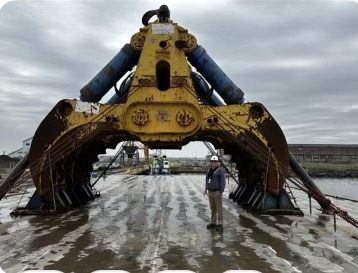
Kiewit’s WEEKS 533 crane barge was instrumental in the cleanup. The Weeks 533 is a 500 short-ton capacity crane and is the largest revolving floating crane on the east coast. It was also the crane used to lift the US Airway’s downed Airbus A320, Flight 1549 (2009) from the Hudson River (Miracle on the Hudson).
Cashman Dredging’s DALE PYATT was the first of the big boys on the scene. The PYATT is a 1200-ton, 180-foot-long dredge equipped with a 60-cubic-yard bucket, making it one of the largest clamshells in the Western Hemisphere. Finally, a vessel known as the “PULVERIZER” entered the scene. The PULVERIZER is a Sterling Equipment Company brain child. It’s a crane barge set-up that uses a massive bell shape wrecking ball that drops into the river to break up the collapsed roadway and bridge deck into manageable pieces. The PULVERIZER and the DALE PYATT worked in tandem pulverizing and scooping wreckage and debris from the seafloor.
Reflecting on that day, and the remarkable clean-up efforts that followed, Jennifer Carpenter, President of the American Maritime Partnership said: “The Francis Scott Key Bridge collapse was a dark day for America. We are indebted to the American mariners who worked tirelessly alongside the U.S. Coast Guard to safely and efficiently clear wreckage, reopen the channel, and restore shipping to and from the Port Baltimore. This reliable, dedicated capacity underscores the importance of the Jones Act in ensuring this industry is ready to respond in moments of crisis whenever they strike.”
A major yet often unreported part of the entire clean up was the use of facilities and land provided by Tradepoint Atlantic in Sparrows Point, Baltimore County, Maryland. Tradepoint Atlantic is a global logistics center that includes the old Sparrows Point Shipyard. The location of Tradepoint is about 1-1/2 nautical miles from the FSK bridge. Slavage, dredging and marine construction crews transported huge portions of the bridge’s wreckage to Tradepoint for processing, screening and crushing. Tradepoint’s sprawling land mass and specialized equipment enabled the crews and shoreside workers to cut, burn and dismantle large steel sections of the bridge. Tradepoint also played a significant role in keeping commerce flowing by accepting rerouted Roll-on, Roll-off (RoRo) vessels and Pure Car Truck Carriers (PCTCs) delivering automobiles that could not unload at Maryland’s Dundalk and Masonville auto terminals.
Key milestones and benchmarks dates:
- March 26, 2024 (Day 1): FSK Bridge collapses, initial mobilization of DALE PYATT and survey boats.
- March 27, 2024 (Day 2): Tradepoint Atlantic opens its property for docking ships, staging of equipment, steel recycling and receiving roadway material for crushing.
- March 26-29, 2024 (Days 1-4): Mobilization begins with an armada of vessels heading to the Baltimore region.
- March 30, 2024 (Day 4): U.S. Army Corps of Engineers and U.S. Coast Guard establish the FSK salvage plan.
- April 1, 2024 (Day 6): Sollers Point Temporary Alternate Channel: 11’ deep, 264’ wide, 95’ clearance opened.
- April 2, 2024 (Day 7): Hawkins Point Temporary Access Channel: 14’ deep, 280’ wide, 124’ clearance opened.
- April 7, 2024 (Day 12): The careful removal of containers from M/V Dali begins.
- April 19, 2024 (Day 24): Fort Carrol Temporary Access Channel: 20’ deep, 300’ wide, 135’ clearance is opened.
- April 25, 2024 (Day 30): Limited Access Deep Draft Federal Channel: 34’ deep, 300’ wide, 214’ clearance (1 month mark – about 75% of ships could access the Port of Baltimore)
- May 13, 2024 (Day 48): Controlled demolition of Section 4, which had pinned the M/V Dali under a 10-million-pound segment of Key Bridge wreckage.
- May 20, 2024 (Day 56): MV DALI removed from site.
- June 10, 2024 (Day 77): Fort McHenry Channel officially fully restored 50 feet deep, 700 feet wide (11-week mark).
By any measurement, the cleanup operation following the collapse of the FSK Bridge was a remarkable success. The United States Merchant Marine and the American maritime industry stepped up to the task. Approximately 50,000 tons of concrete and debris was removed from the Patapsco River. The Port of Baltimore was reopened in 11 weeks as opposed to the 11 months that some experts predicted. Americans take care of America. A job well done!
Note: Excerpts of this article appeared in several trade publications owned by New Wave Media, including Marine Link, Maritime Logistics Professional, Marine Technology Reporter Group, Marine News and Maritime Reporter and Engineering News.
About the Author: William P. Doyle is the CEO of the Dredging Contractors of America and the former Chief Executive of the Port of Baltimore and U.S. Federal Maritime Commissioner. He is a graduate Massachusetts Maritime Academy and Widener University Commonwealth Law School. He served ten years as a marine engineer in the U.S. Merchant Marine.

